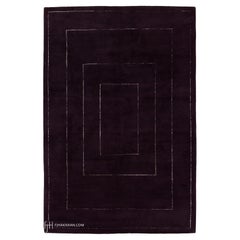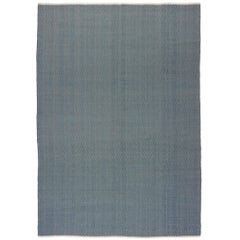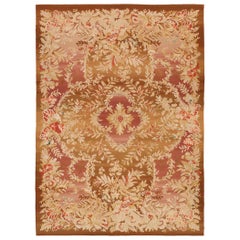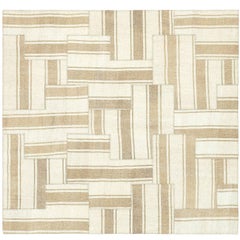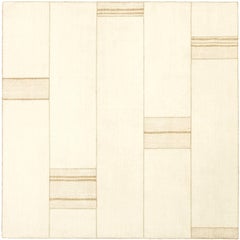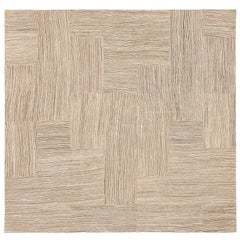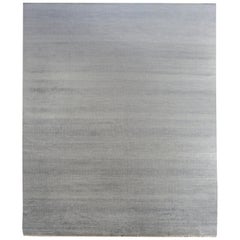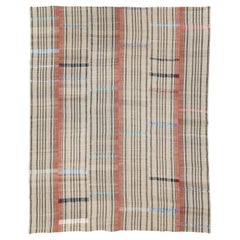FJ Hakimian More Carpets
to
Width
to
Length
to
21
6
2
1
20
6
6
14
1
1
19
19
2
2
1
27
27
27
27
18
12
12
12
5
Contemporary "Ruhlmann 1930" Rug
Located in New York, NY
Contemporary "Ruhlmann 1930" rug
Two levels, pile and loop.
Field: Eggplant color wool
Design: Bleached silk
Category
2010s Nepalese Minimalist More Carpets
Materials
Wool, Silk
Contemporary Flat-Weave 'A-6' Design Carpet
Located in New York, NY
Contemporary flat-weave 'A-6' design carpet
Thick flat-weave technique.
Handwoven, 70% wool, 30% cotton
Category
2010s Philippine More Carpets
Materials
Wool, Cotton
Contemporary 'FALL' Carpet
Located in New York, NY
Contemporary 'FALL' carpet
Flat-weave, 100% wool woven on cotton foundation.
China, circa 2003.
Category
21st Century and Contemporary Chinese Bessarabian More Carpets
Materials
Wool
$53,880
Mid-20th Century Vintage Kilim Composition Carpet
Located in New York, NY
Vintage kilim composition - The Gate design. Vintage Turkish panels, coarse weave, oatmeal with soft camel color stripes. The stitch: simple-strengthened &...
Category
Mid-20th Century Turkish Kilim More Carpets
Materials
Wool
Mid-20th Century Vintage Kilim Composition Carpet
Located in New York, NY
Vintage Kilim composition: Five white Turkish panels in composition with six pieces (stripes- camel color on white piece, coarse weave, hemp).
Stitch: Regular Herringbone stitch be...
Category
Mid-20th Century Turkish Kilim More Carpets
Materials
Wool, Linen
Mid-20th Century Vintage Kilim Composition Carpet
Located in New York, NY
Vintage Kilim composition - The Gate design. Moroccan rare panels:white & brown striped. The stitch: regular herringbone with button stitch on the edges.
Category
Mid-20th Century Moroccan Kilim More Carpets
Materials
Wool
Mid-20th Century Vintage Kilim Composition Carpet
Located in New York, NY
Vintage Kilim composition - Deco Fan design. Mix of Turkish and Persian panels.
Category
Mid-20th Century Turkish Kilim More Carpets
Materials
Wool
Contemporary 'Marion II' Grey Tibetan Wool and Silk Carpet
Located in New York, NY
Contemporary 'Marion II' Grey Tibetan Wool and Silk Carpet
This Tibetan wool and silk rug was inspired by the modern aesthetic of the 20th century.
Enhancing its flossy textural feel...
Category
21st Century and Contemporary Nepalese Modern More Carpets
Materials
Wool, Goat Hair, Silk
Contemporary 'Summit' Carpet
Located in New York, NY
Contemporary 'Summit' carpet
Two levels, cut pile and loop border:
Bleached New Zealand wool (pile) and nettle (loop).
Category
21st Century and Contemporary Nepalese Modern More Carpets
Materials
Wool, Natural Fiber
$17,628
Contemporary South African Handwoven Rush Mat
Located in New York, NY
Contemporary South African Handwoven Rush Mat
South Africa, circa 2017
Handwoven, rush
Category
2010s African More Carpets
Materials
Rush
Vintage Ukrainian Rug
Located in New York, NY
Vintage Ukrainian rug circa 1900
Handwoven, high pile.
Category
Antique Early 1900s Ukrainian Bessarabian More Carpets
Materials
Wool
$14,000
Early 20th Century East European Bessarabian Kilim
Located in New York, NY
Early 20th century East European Bessarabian Kilim
East Europe, circa 1910
Handwoven
Size: 11'4" x 7'6" (345 x 229 cm).
Category
Early 20th Century European Bessarabian Russian and Scandinavian Rugs
Materials
Wool
Eastern European Thracian Kilim
Located in New York, NY
Eastern European Thracian Kilim,
circa 1920
Handwoven.
Category
Vintage 1920s European More Carpets
Materials
Wool
Ukranian Pile Carpet with Floral Design, 19th Century
Located in New York, NY
Ukrainian pile carpet with floral design, 19th century.
Urania, circa early 19th century
Handwoven.
Category
Antique Early 19th Century Ukrainian More Carpets
Materials
Wool
Mid-20th Century Vintage Kilim Composition Carpet
Located in New York, NY
Vintage kilim composition - Art Deco design. Turkish Panels.
Category
Mid-20th Century Turkish Kilim More Carpets
Mid-20th Century Vintage Kilim Composition Carpet
Located in New York, NY
Vintage Kilim composition - Spinning star design.Turkish panels: white (100% cotton, textured), white and blue (linen & cotton)
Category
Mid-20th Century Turkish Kilim More Carpets
Mid-20th Century Vintage Kilim Composition
Located in New York, NY
Vintage Kilim composition - Modernistic design. Turkish Panels, brown, white and ochre panels.
Category
Mid-20th Century Turkish More Carpets
Materials
Wool
Mid-20th Century Vintage Kilim Composition Carpet
Located in New York, NY
Vintage kilim composition - Modernistic design.
Category
Mid-20th Century Moroccan Kilim More Carpets
Materials
Wool
Mid-20th Century Vintage Kilim Composition Carpet
Located in New York, NY
Vintage kilim composition. Based on a Swedish design.Turkish Panels.
Category
Mid-20th Century Turkish Kilim More Carpets
Materials
Wool
Early 20th Century Vintage Kilim Composition Carpet
Located in New York, NY
Vintage Kilim composition - Langley design.
Category
Early 20th Century Turkish Kilim More Carpets
Materials
Wool
Mid-20th Century Vintage Kilim Composition Carpet
Located in New York, NY
Vintage Kilim composition. Turkish wool, hemp, linen and cotton panels. Bronze wire stitching.
Category
Mid-20th Century Turkish Kilim More Carpets
Mid-20th Century Vintage Kilim Composition Carpet
Located in New York, NY
Vintage Kilim composition - Deco Fan design. Turkish linen and cotton panels with basic Herringbone stitching in natural linen.
Category
Mid-20th Century Turkish Kilim More Carpets
Mid-20th Century Vintage Kilim Composition Carpet
Located in New York, NY
Vintage Kilim composition - Brada design. Mix of Turkish and Persian panels.
Category
Mid-20th Century Turkish Kilim More Carpets
Mid-20th Century Vintage Kilim Composition Carpet
Located in New York, NY
Vintage Kilim composition. Mix of Turkish and Persian Panels.
Category
Mid-20th Century Turkish Kilim More Carpets
Early 20th Century Thracian Carpet
Located in New York, NY
Eastern Europe ca. 1920
11'8" x 10'9" (356 x 328 cm)
Category
Early 20th Century European More Carpets
Materials
Wool
Early 20th Century Khotan Carpet
Located in New York, NY
Early 20th century Khotan carpet.
Category
Early 20th Century Tibetan More Carpets
Mid-20th Century 'Linear' Vintage Kilim Composition Carpet
Located in New York, NY
Vintage Kilim composition - Linear design. Persian panels, Herringbone stitching with button stitch on the edges, all of linen.
Category
Mid-20th Century American Kilim More Carpets
Materials
Wool
Related Items
Melody Grass Contemporary Rug
Located in Chicago, IL
A beautiful contemporary Indian hand knotted wool rug with a sophisticated geometric and striped pattern called Melody Grass, woven in contrasting shades of gray. There is no border.
Category
21st Century and Contemporary Indian Modern Indian Rugs
Materials
Wool
Mid-20th Century Handmade Turkish Flatweave Kilim Room Size Carpet
Located in New York, NY
A vintage Turkish flatweave Kilim room size carpet handmade during the mid-20th century.
Measures: 11' 0" x 14' 0".
Category
Mid-20th Century Turkish Rustic Turkish Rugs
Materials
Wool
New Contemporary Moroccan Carpet
By Berber Tribes of Morocco
Located in Dallas, TX
30340 New Contemporary Moroccan Style rug 10'00 x 13'09. Displaying an expressive design with incredible detail and texture, this hand knotted wool contemporary Moroccan area rug is ...
Category
21st Century and Contemporary Indian Bohemian Moroccan and North African...
Materials
Wool
Mid-20th Century Handmade Turkish Flatweave Kilim Room Size Carpet
Located in New York, NY
A vintage Turkish flatweave Kilim room size carpet handmade during the mid-20th century.
Measures: 11' 3" x 15' 1".
Category
Mid-20th Century Turkish Rustic Turkish Rugs
Materials
Wool
Zabihi Collection Floral Vintage European Carpet
Located in New York, NY
Worn mid-20th century European carpet with a matching floral field and motif in dominant green and pink shades.
Measures: 9'10'' x 13'.
Category
20th Century Bulgarian Bessarabian Western European Rugs
Materials
Wool
Vintage Turkish Bessarabian Rose Carpet
Located in Dallas, TX
72090 Vintage Floral Turkish Kilim Rug, 06’09 x 09’06. Turkish Kilim rugs with Bessarabian Rose designs are a distinct style of Kilim rugs crafted in Turkey, featuring floral motifs inspired by the historical Bessarabian rose designs originating from regions like Moldova, Ukraine, and Romania. These rugs exhibit intricate floral patterns, including stylized roses, arranged in geometric or symmetrical layouts, known for their elegance, intricacy, and vibrant colors. By integrating Bessarabian rose designs into traditional Kilim weaving techniques, Turkish weavers create a unique fusion of cultural influences, showcasing Turkish craftsmanship while honoring the rich floral traditions of Bessarabia. Highly prized for their beauty, craftsmanship, and cultural significance, these rugs can elevate interior decor as focal points, reflecting the heritage of both Turkish and Bessarabian weaving traditions.
Embrace the timeless elegance of a rose garden in perpetual bloom with this exquisite handwoven wool vintage Turkish rose kilim rug...
Category
Mid-20th Century Turkish Bessarabian Turkish Rugs
Materials
Wool
Needlepoint Flat Weave Carpet 6' 0" x 9' 0"
Located in New York, NY
Needlepoint. Hand made wool rug. Measures: 6'0" x 9'0".
Category
21st Century and Contemporary Chinese More Carpets
Materials
Wool
Mid-20th Century Handmade Turkish Flat-Weave Kilim Accent Carpet
Located in New York, NY
A vintage Turkish flat-weave Kilim accent carpet handmade during the mid-20th century.
Measures: 6' 10" x 9' 7"
Flat-weave rugs & carpets:
Knotted pile rugs are just one small part of a vast universe of textile techniques suitable for heavy use. If you can imagine it, some weaver has tried it out. Pieces can be roughly divided into those reversible from the start and those never, or at least not initially, reversible. Thus, kilims are considered reversible, while everything else is not.
Kilims are tapestry woven rugs with both sides the same, in either slit technique where colors change, or with various methods of avoiding slits. Slit tapestry weave goes back to ancient times and Coptic Egyptian weavers used it for ornaments on garments and larger wall hangings. Slits can be avoided by dovetailing of colors (warp sharing) or by interlocking the wefts. The Navajo weavers of the Southwest practice the first while the Fine shawl weavers of Kashmir and Kerman employed the second. Interlocking produces a one-faced fabric, with smooth and rough, ridged faces. The typical Turkish, Caucasian, or Persian rustic Kilim shows slits, but never long ones. Aubusson French carpets are also slit tapestries and the long color transitions are sewn up as part of the regular maintenance. Some kilims are very Fine. The best antique urban Sehna (Senna) kilims on wool, cotton or silk warps approximate the comparable rugs in refinement and are the most desirable of all Persian kilims. Although the various flatweave techniques are usually expressed in geometric, simple, often repeating, patterns, Sehna kilims demonstrate that even the most intricate designs can be effectively rendered in flat-stich. The term ‘Kilim’ has been extended to cover any pileless, weft-faced heavy textile. Thus, the sectioned and joined northeastern Persian horizontally striped wool rugs are called ‘kilims’. So are the plain-weave end finishes of pile rugs. All these are weft-faced, weft patterned flatweaves.
These sectioned pieces are woven not on a frame loom, but one steadied by the weaver at one end and with the warps fastened down at the other. Only relatively recent have these tribal pieces become available. They are used as floorcoverings, hangings, room dividers, furniture covers. They are mostly bitonal in shades of natural dark brown and beige. Some more recent pieces show weaver innovations with ikat and moire effects. Work proceeds quickly and a skilled weaver can complete a thirty foot strip in almost no time.
Wefts, the elements added as weaving progresses, play an essential part in what is a flatweave. The best-known example of an extra-weft, wrapping technique is on Caucasian and tribal Persian Soumaks, where a pattern weft wraps around the fixed warp, changing as weaving progresses. Soumaks can be large carpets, Kuba in the Caucasus, small bag faces (Caucasian and Persian Shah Savan saddle bags), or cover scatter rugs (Persian Afshars). The Soumak technique is fast, and a weaver can work much more quickly than tying knots. The left-over wefts are cut off on the back, so the front and back are initially different. As a Soumak on the floor gets used, these weft yarns wear away and the two sides converge although the exact texture remains distinct.
There are other ways of pattern by weft. Often on smaller tribal pieces, the pattern weft(s) is (are) part of the weft structure, moving in an out, and holding the whole thing together. These wefts can be complementary or added (supplementary), continuous across the flatweave or cut off as they travel unneeded across the verso. Supplementary weft flatweaves are often very compact and substantial. The nomadic Turkmen and Balouch tribes employ both supplementary and complementary weft techniques on their pieces. Supplementary wefts are often raised on the recto (front) while complementary wefts are flat to the surface. Tribal Kurds employ this extra-wefting technique. The Balouch of Pakistan use complementary wefts almost exclusively on their small woven paraphernalia like salt bags.
Flatweave techniques may be combined on a single piece. Afshar rugs employ plain-weave end strips, preceded by Soumak bands, with pile sections between. The large Bakhtiari saddlebags feature Soumak work, pile “islands” an areas of plain-weave. Qashqai rugs and kilims frequently displays checkerboard end strips in continuous, complementary wefting.
Another distinct flatweave type is the jajim (jijim, cecim) in which a pattern is added with colored wefts as the weaving of the plain-weave ground progresses. Here the wefts are discontinuous and the pattern stands proud from the voided ground. Often made in two pieces on narrow looms and edge-sewn together, these may have geometric patterns. The term ‘jajim’ also refers to the assembled warp-faced strip and stripe covers from the Shah Savan of northwest Persia, the pattern is defined by warps alone, usually in plain stripes, but sometimes in designs of ladders, snakes, human figures and various animals. Here the color changing warps are continuous. Most are wool, a few are silk. Better to call these something else.
Indian ‘Dhurries’ are all cotton kilims and ‘shatrangis’ employ wool wefts on cotton warps. Dhurries are slitless. The cotton texture is more appropriate to the humid and warm climate of the Indian subcontinent. Modern Dhurries...
Category
Mid-20th Century Turkish Tribal Turkish Rugs
Materials
Wool
New Contemporary Moroccan Carpet
Located in Dallas, TX
80797 new Contemporary Moroccan rug, 08'06 x 09'10. Showcasing an expressive design, incredible detail and texture, this hand knotted woo...
Category
21st Century and Contemporary Pakistani Spanish Colonial Moroccan and No...
Materials
Wool
New Contemporary Moroccan Carpet
By Berber Tribes of Morocco
Located in Dallas, TX
80708 new contemporary Moroccan Gallery rug with Tribal style 06'01 x 13'00. With its simplicity, plush pile and tribal style, this hand knotted wool contemporary Moroccan gallery ru...
Category
21st Century and Contemporary Pakistani Mid-Century Modern Moroccan and ...
Materials
Wool
Magico Carpet, Wool Velvet and Bouclé Hand-Tufted Contemporary Carpet
By MARCANTE - TESTA, SEM
Located in Brooklyn, NY
Velvet and bouclé hand-tufted contemporary carpet made with New Zealand precious wool and Tencel. A special sartorial touch is beautifully enhanced by the carving technique. The geom...
Category
21st Century and Contemporary Italian Modern More Carpets
Materials
Wool, Acrylic
$14,212 / item
W 98.43 in L 137.8 in
Contemporary Turkish Flat-Weave Kilim Large Room Size Carpet
Located in New York, NY
A modern Turkish flat-weave Kilim large room size carpet handmade during the 21st century.
Measures: 13' 2" x 16' 6"
Flat-weave rugs & carpets:
Knotted pile rugs are just one small part of a vast universe of textile techniques suitable for heavy use. If you can imagine it, some weaver has tried it out. Pieces can be roughly divided into those reversible from the start and those never, or at least not initially, reversible. Thus, kilims are considered reversible, while everything else is not.
Kilims are tapestry woven rugs with both sides the same, in either slit technique where colors change, or with various methods of avoiding slits. Slit tapestry weave goes back to ancient times and Coptic...
Category
21st Century and Contemporary Turkish Modern Turkish Rugs
Materials
Wool
